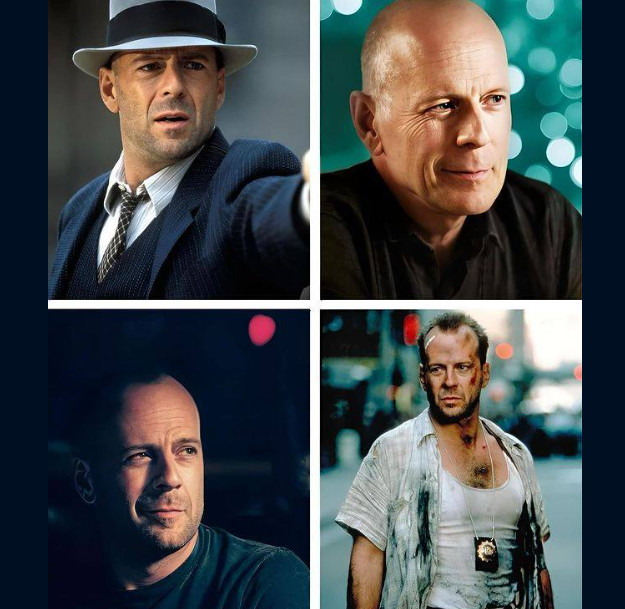In the annals of Hollywood history, certain figures stand out not just for their talent, but for their ability to redefine the very essence of stardom. Bruce Willis is undeniably one such luminary. From his humble beginnings as a television star to his meteoric rise as an action icon, Willis has shattered stereotypes and redefined the parameters of success in the entertainment industry. In this comprehensive exploration, we delve into the unexpected journey of Bruce Willis, tracing how he transformed from a comedic TV actor to a multi-faceted Hollywood powerhouse.
- From TV Star to Action Hero
Before Bruce Willis graced the silver screen as the indomitable John McClane in “Die Hard,” he was best known for his role as the wisecracking private detective David Addison in the hit television series “Moonlighting.” Willis’s portrayal of Addison showcased his comedic prowess and charismatic charm, earning him critical acclaim and a loyal fan base. However, it was his unexpected foray into the action genre that would catapult him to international stardom.
When Willis was cast as the iconic John McClane in “Die Hard” (1988), many were skeptical of his ability to embody the role of an action hero. Yet, Willis defied all expectations with his gritty portrayal of the everyman cop caught in a high-stakes terrorist situation. His performance was a revelation, blending wit, vulnerability, and raw intensity in equal measure. With “Die Hard,” Willis not only proved his action chops but also demonstrated that actors could successfully transition between genres, transcending the limitations of typecasting.
- Balancing Action with Depth
What set Bruce Willis apart from other action stars of his time was his uncanny ability to infuse his characters with depth and humanity. While his roles often involved high-octane action sequences, Willis never lost sight of the emotional core of his characters. Whether it was the stoic resilience of John McClane or the haunted introspection of James Cole in “12 Monkeys” (1995), Willis brought a level of nuance and complexity to his performances that elevated them beyond mere action tropes.
In “Die Hard,” Willis portrayed McClane as a flawed and relatable hero, grappling with personal demons even as he battled terrorists. This multidimensional portrayal resonated with audiences, paving the way for a new breed of action heroes who were not afraid to show vulnerability. Willis proved that action films could be more than just mindless spectacle; they could also be vehicles for exploring deeper themes of resilience, redemption, and human frailty.
- Genre-Bending Versatility
One of the hallmarks of Bruce Willis’s career is his willingness to take risks and explore diverse genres. From action comedies to sci-fi thrillers, Willis has showcased his versatility as an actor time and again. In films like “True Lies” (1994) and “The Fifth Element” (1997), he demonstrated his comedic timing and knack for physical comedy, earning accolades for his effortless charm and wit.
However, Willis’s talents extend far beyond the realm of action and comedy. In Terry Gilliam’s “12 Monkeys,” he delivered a tour de force performance as a time-traveling convict haunted by visions of a dystopian future. The role earned Willis critical acclaim and a Golden Globe Award, proving his prowess as a dramatic actor capable of commanding the screen with his intensity and gravitas.
But perhaps most surprising of all was Willis’s foray into animation with “Rugrats Go Wild” (2003), where he lent his distinctive voice to the character of Spike. This unexpected detour into the world of animation showcased Willis’s willingness to step outside his comfort zone and embrace new challenges, further solidifying his reputation as a true chameleon of the silver screen.
- Paving the Way for Others
Bruce Willis’s impact on the entertainment industry extends far beyond his own illustrious career. As one of the first actors to successfully transition from television to film and from comedy to action, he paved the way for future generations of performers to follow in his footsteps. Actors like Arnold Schwarzenegger and Sylvester Stallone, once pigeonholed as action stars, were inspired by Willis’s example to explore new avenues and expand their range as artists.
Conclusion
In conclusion, Bruce Willis’s journey from TV star to action hero to multi-faceted actor is a testament to the power of perseverance, versatility, and sheer talent. Through his groundbreaking performances and fearless experimentation, Willis challenged the conventions of Hollywood stardom and redefined what it means to be a successful actor in the modern era. His legacy will continue to inspire generations of performers to break free from the constraints of typecasting and embrace the limitless possibilities of their craft. In the ever-evolving landscape of cinema, Bruce Willis will always stand as a beacon of innovation and inspiration, reminding us that true greatness lies in daring to be unexpected.



